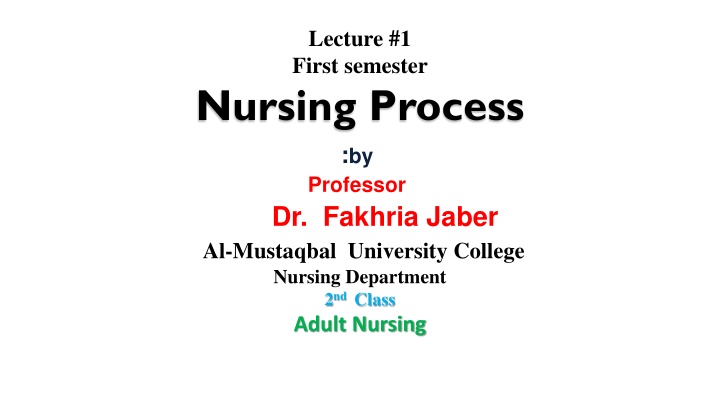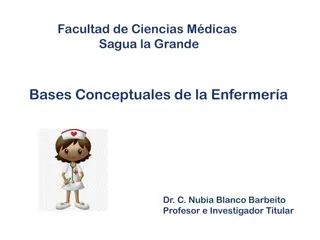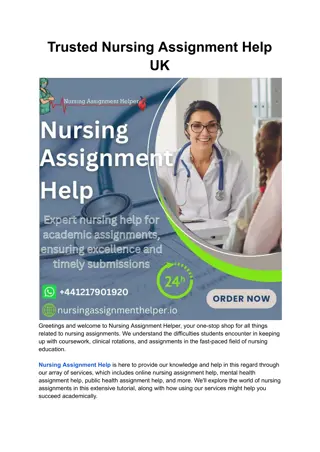Nursing Process Overview: Assessment to Data Collection
The nursing process is a systematic problem-solving approach to meet healthcare needs. The key components include assessment, diagnosis, planning, implementation, and evaluation. The initial step is assessment, gathering data through various methods. Different types of assessments such as data-based, focus, emergency, and ongoing are crucial. Data collection is vital for patient care as it provides complete, accurate, and relevant information. Primary and secondary sources of data, as well as subjective and objective data types, play a crucial role in understanding the patient's health status.
Download Presentation

Please find below an Image/Link to download the presentation.
The content on the website is provided AS IS for your information and personal use only. It may not be sold, licensed, or shared on other websites without obtaining consent from the author.If you encounter any issues during the download, it is possible that the publisher has removed the file from their server.
You are allowed to download the files provided on this website for personal or commercial use, subject to the condition that they are used lawfully. All files are the property of their respective owners.
The content on the website is provided AS IS for your information and personal use only. It may not be sold, licensed, or shared on other websites without obtaining consent from the author.
E N D
Presentation Transcript
Lecture #1 First semester Nursing Process :by Professor Dr. Fakhria Jaber Al-Mustaqbal University College Nursing Department 2nd Class Adult Nursing
The nursing process Is a deliberate problem-solving approach for meeting people s health care and nursing needs. Although the steps of the nursing process have been stated in various ways by different writers, the common components cited are assessment, diagnosis, planning, implementation, and evaluation (2017).
Characteristic of Nursing Process Provide the framework for care. It is client center. Adapted of problem solving technique. It has planned. It is cyclic and dynamic. 3
1- Assessment The first step in the nursing process that include systematic collection of data through interview, observation, and examination to determine the patient s health status as well as any actual or potential health problems
Types of assessment Data base assessment comprehensive information you gather on initial contact with the person to assess all aspects of health status. Focus assessment the data you gather to determine the status of a specific condition. Emergency assessment: the data you gather to determine the threatening status of a specific condition related to CAB system. Ongoing assessment or (follow-up ) Data gathering extended to the client discharge to maintain his health condition
Data collection Data collection Is the process of gathering information about client health status. The collection of patient data is vital steps in nursing process because the remaining steps depend on these steps. Characteristic of data: Complete. Accurate Relevant.
Data collection Sources of Data Primary source: Client Secondary source: Client s family, reports, test results, information in current and past medical records. Types of data Subjective data: (symptoms, covert data), the client only client can be described. Such as itching, pain, feeling, I feel weak all over. Objective data: referred to as (signs or overt data) are detectable by observe or can be measured, it can be seen, heard. Example Blood pressure reading, pulse, redness, cyanosis. Blood pressure: 90/ 50 mmHg.
Methods of Data Collection 1. Observation 2. Interview Notes the general appearance and behavior of the client Helps to determine the client s status, both physical and mental Preparation Stages Introduction Working Closure
Methods of Data Collection 4. Physical examination Assessment techniques Inspection Palpation Percussion Auscultation 5. Laboratory and diagnostic data
Subjective Data A. Biographical data (demographical data) (ID) 1. Name 2. Age 3. Gender (male-or-female) 4. Marital status (married, single, divorce) 5. Educational level ( primary, secondary, diploma, .) 6. Occupation (worker, officer, gainer( 7. Religion(Muslimism, Jewish, Christian 8. Birth date 9. Birth place 10. Phone number 11. Phone number of significant person 12. Address
Subjective Data B. Past history 1. Previous Illness or Diseases 2. Previous Surgery 3. Allergies > (from food, drug) 4. Accident and injury 5. Immunization 6. Medication 7. Previous hospitalization C. Present history (pain assessment) 1. C: Characteristics 2. O: Onset 3. L: Location + Radiation 4. D: Duration 1. S: Severity (0-10 scale) 0-4 mild\ 5-6 moderate\ 7-10 sever 5. P: Pattern 6. A: Association sign and symptom
Subjective Data D. Family History (genogram) Diseased Diseased (continued)
Subjective Data E. Social History 1. Alcohol Use 2. Tobacco Use 3. Drug Use 4. Sleep 5. Diet 6. Exercise 7. Stress 8. Stress Management 9. Economic Status 10. Hobbies and Leisure Activities 11. Roles and Relationships
Subjective Data E. Social History 12. Characteristic Patterns of Daily Living Daly activities (dependent, independent, need assistant) Bathing Dressing Eating Toileting Grooming Drinking Ambulating
2- Nursing Diagnosis: Second step of the Nursing Process that describes clinical judgments about individual, family, or community responses to actual or potential health problems/life processes that can be managed by independent nursing interventions NANDA Definition: (North America Nursing Diagnosis Associate) Nursing diagnosis is a clinical judgment about individual, family, or community responses to actual and potential health problems/life processes. 9/8/2024
A nursing diagnosis (Nsg Dx) vs A medical diagnosis(MD Dx) Within the scope of nursing practice Within the scope of medical practice determines a specific disease, condition or pathological state. Stays the same as long as the disease is present Identify responses to actual or potential health problems/life processes. Can change from day to day
Types of Nursing Diagnoses Actual: A problem exists Imbalanced nutrition; less than body requirements RT chronic diarrhea, nausea, and pain AEB height 5 5 weight 105 lbs. Risk: A problem does not yet exist Risk for falls RT altered gait and generalized weakness.
Components of Nursing Diagnosis It contains three parts: Problem: 1) Identifies unhealthy response 2) Indicates what should change Example: problem Etiology Sign Ex: Anxiety related to Fear of death manifested by patient verbalization. Etiology: 1) Identifies causative or contributing factors suggests nursing interventions Sign and symptom: redness, cyanosis, loss of appetite. It called PES system. Ex: Activity intolerance related to obesity manifested by body weight 140 KG. 19 9/8/2024
1 3 Writing Diagnostic Statements Writing Diagnostic Statements 2
3- Planning Third step of the Nursing Process; That is development of measurable goals and outcomes as well as a plan of care designed to assist the patient in resolving the diagnosed problems and achieving the identified goals and desired outcomes. Planning process: Prioritize problem. Formulate goal. Select nursing intervention. Write nursing order. Record and modify. 21 9/8/2024
Setting Priorities Determine problems that require immediate action Maslow s Hierarchy of Human Needs
Goals Short-Term Goals Outcomes achievable in a few days or 1 week Client-centered Measurable Realistic Accompanied by a target date Long-Term Goals Desirable outcomes that take weeks or months to accomplish for client s with chronic health problems
Components of Outcomes Subject: who is the person expected to achieve the outcome? Verb: what actions must the person take to achieve the outcome? Condition: under what circumstances is the person to perform the actions? Performance criteria: how well is the person to perform the actions? Target time: by when is the person expected to be able to perform the actions? The patient (1) will walk (2) with a walker (3) the length of the hall (4) by the end of the shift (5
Interventions 3 types Independent ( Nurse initiated )- any action the nurse can initiate without direct supervision Dependent ( Physician initiated )-nursing actions requiring MD orders Collaborative- nursing actions performed jointly with other health care team members
4- Implementation forth step of nursing process, The implementation phase of the nursing process involves carrying out the proposed plan of nursing care.. Process of implementation: Reassessing the client. Determine the nurse need for assistance. Implementing. Supervising. Document the action. 26 9/8/2024
5- Evaluation Final step of the Nursing Process that determine the client progress toward goals achievement and effectiveness of the nursing care plan. A comparison of client behavior and/or response to the established outcome criteria Continuous review of the nursing care plan Examines if nursing interventions are working Determines changes needed to help client reach stated goals 27 9/8/2024
Case study: Mrs. A 23 years old admitted to the hospital, married, the temperature is elevated, productive cough, rapid respiration with difficulty. 1) Assessment: V/S are temperature 39.1C, pulse 92 b/m, respiration rate 28 b/m and blood pressure 122/80 mm/hg. nurse observe that Mrs. A is dry skin, her cheeks are flushed, she is experience of chill. On chest, auscultation reveals respiratory crackles. 9/8/2024
2) Diagnosis: Ineffective breathing pattern related to accumulation of secretion as manifested by productive cough, rapid respiration with difficulty. 3) Planning: Goal: The patient (S) will able to breath (V) normally (c) within 8 hours (T). Restore effective breathing pattern. Interventions: Deep breathing exercise. Increase fluid intake, Bronchodilator medications. 30 9/8/2024
4) Implementation: Mrs. A agree to practice: Deep breathing exercise q4hrs. Increase the fluid intake. Take bronchodilator medications. 5) Evaluation: (The goal not met) the nurse detects failure of the client to breath normally, the plan modify to reach normal breathing and then reevaluation. 31 9/8/2024
Thanks For Listening























